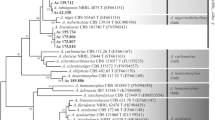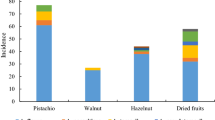Abstract
The garlic contains sulfur bioactive compounds responsible for medicinal properties. The decrease of these compounds due to inadequate storage conditions reduces the beneficial properties and favors infection by microorganisms. Several studies have shown high frequency of garlic infected with Aspergillus section Nigri that potentially produce mycotoxin. Garlic samples were collected in markets of Brazil and a total of 32 samples (of 36) had the fungal infection with predominant genus Aspergillus (50.3%), Penicillium (34.7%), and Fusarium (11%). A total of 63% (649/1031) of infection with Aspergillus section Nigri, of which 60 isolates were selected for analysis of genetic variability that resulted in 4 clusters. Representatives of clusters were identified by the calmodulin gene. Isolates from cluster I were subdivided into A-I and identified as A. niger (16 isolates) and the isolates of clusters B-I, II, and III were identified as A. welwitschiae (43 isolates). Besides, an isolate of the IV-cluster was identified by A. luchuensis. Further, we used the multiplex PCR to verify genotypes of 59 isolates, and none of these had OTA production-associated genotype. Moreover, 19 A. welwitschiae and 15 A. niger were FB2 production-associated genotype. Our study is the first report to the incidence of garlic infection in Brazil and to show that A. welwitschiae causes most of these infections.



Similar content being viewed by others
References
Fao (2016) Production and trade statistics
Randle WM, Lancaster JE (2002) Sulphur compounds in alliums in relation to flavour quality. In: Rabinowitch HD, Currah L (ed) Allium crop science: recent advances. CAB Int., Wallingford, p 329–356.
Lanzotti V, Scala F, Bonanomi G (2014) Compounds from Allium species with cytotoxic and antimicrobial activity. Phytochem Rev 13:769–791
Banerjee SK, Mukherjee PK, Maulik SK (2003) Garlic as an antioxidant: the good, the bad and the ugly. Phytother Res 17:97–106
Amagase H (2006) Clarifying the real bioactive constituents of garlic. J Nutr 136:7165–7255
Alorainy MS (2011) Evaluation of antimicrobial activity of garlic (Allium sativum) against E. coli O 157: H 7. J Agric Vet Sci 4:149–457
Chen S, Shen X, Cheng S, Li P, Du J, Chang Y, Meng H (2013) Evaluation of garlic cultivars for polyphenolic content and antioxidant properties. PLoS ONE 8:e79730
Kumar R, Chhatwal S, Arora S, Sharma S, Singh J, Singh N, Khurana A (2013) Antihyperglycemic, antihyperlipidemic, anti-inflammatory and adenosine deaminase-lowering effects of garlic in patients with type 2 diabetes mellitus with obesity. Diabetes Metab Syndr Obes 6:49–56
Borlinghaus J, Albrecht F, Gruhlke MCH, Nwachukwu ID, Slusarenko AJ (2014) Allicin: chemistry and biological properties. Molecules 19:12591–12618
Capasso A (2014) Antioxidant action and therapeutic efficacy of Allium sativum L. Molecules 18:690–700
Rahman MS (2007) Allicin and other functional active components in garlic: health benefits and bioavailability. Int J Food Prop 10:245–268
Shadkchan Y, Shemesh E, Mirelman D, Miron T, Rabinkov A, Wilchek M, Osherov N (2004) Efficacy of allicin, the reactive molecule of garlic, in inhibiting Aspergillus spp. in vitro, and in a murine model of disseminated aspergillosis. J Antimicrob Chemother 53:832–836
Irkin R, Korukluoglu M (2007) Control of Aspergillus niger with garlic, onion and leek extracts. Afr J Biotechnol 6:384–387
Irkin R, Korukluoglu M (2009) Control of some filamentous fungi and yeasts by dehydrated Allium extracts. J Verbrauch Lebensm 4:3–6
Guevara-Figuero T, López-Hernández L, Lopez MG, Dufoo HMD, Vázquez-Barrios ME, Guevara-Olvera L, Mercado-Silva EM (2015) Conditioning garlic ‘‘seed” cloves at low temperature modifies plant growth, sugar, fructan content, and sucrose fructosyltransferase (1-SST) expression. Sci Hortic 189:150–158
Fei MLI, Tong LI, Wei LI, De Yang L (2015) Changes in antioxidant capacity, levels of soluble sugar, total polyphenol, organosulfur compound and constituents in garlic clove during storage. Ind Crops Prod 69:137–142
MacDonald S, Castle LA (1996) UK retail survey of aflatoxin in herbs and spices and their fate during cooking. Food Addt Contam 13:121–128
Patel S, Hazel CM, Winterton AGM, Mortby E (1996) Survey of ethnic foods for mycotoxins. Food Addt Contam 13:833–841
Gnonlonfin GJB, Adjovi YC, Tokpo AF, Agbekponou ED, Ameyapoh Y, De Souza C, Brimer L, Sanni A (2013) Mycobiota and identification of aflatoxin gene cluster in marketed spices in West Africa. Food Control 34:115–120
Toma FM, Abdulla NQF (2013) Isolation and identification of fungi from spices and medicinal plants. Res J Environm Ear Sci 5:131–138
Tancinová D, Mokrý M, Barboráková Z, Masková Z (2014) Mycobiota of spices and aromatic herbs. Potravinarstvo Sci J Food Ind 8:172–177
Ghangaonkar NM (2013) Incidence of mycoflora on garlic (Allium sativum L.) bulbs. Int Res J Biol Sci 2:44–64
Fontenele LM dos S, Azevedo MLX, Cardoso-Filho FC, Muratori MCS, Sá LRS, Pereira MMG (2015) Qualidade microbiológica do alho (Allium sativum) produzido e comercializado em mercados públicos. Rev Inst Adolfo Lutz 74
Oh JY, Mannaa M, Han GD, Chun SC, Kim KD (2016) First report of Aspergillus awamori as a fungal pathogen of garlic (Allium sativum L.). Crop Prot 85:65–70
Abarca ML, Bragulat MR, Castellá G, Cabañes FJ (1994) Ochratoxin A production by strains of Aspergillus niger var. niger. Appl Environ Microbiol 60:2650–2652
Frisvad JC, Smedsgaard J, Samson RA, Larsen TO, Thrane U (2007) Fumonisin B2 production by Aspergillus niger. J Agric Food Chem 55:9727–9732
Varga J, Baranyi N, Chandrasekaran M, Vágvolgyi C (2015) Mycotoxin producers in the Aspergillus genus: an update. Acta Biol Szeged 59:151–167
Perrone G, Stea G, Epifani F, Varga J, Frisvad JC, Samson RA (2011) Aspergillus niger contains the cryptic phylogenetic species Aspergillus awamori. Fungal Biol 115:1138–1150
Orlandelli RC, Specian V, Felber AC, Pamphile JA (2012) Enzimas de interesse industrial: produção por fungos e aplicações. SaBios 7:97–109
Hong SB, Lee M, Kim DH, Varga J, Frisvad JC, Perrone G, Gomi K, Yamada O, Machida M, Houbraken J, Samson RA (2013) Aspergillus luchuensis, an industrially important black Aspergillus in East Asia. PLoS ONE 8:e63769
Samson RA, Visagie CM, Houbraken J (2014) Phylogeny, identification and nomenclature of the genus Aspergillus. Stud Mycol 78:141–173
Abbas HK, Wilkinson JR, Zablotowicz RM, Accinelli C, Abel CA, Bruns HA, Weaver MA (2009) Ecology of Aspergillus flavus, regulation of aflatoxin production, and management strategies to reduce aflatoxin contamination of corn. Toxin Ver 28:142–153
Massi FP, Sartori D, de Souza FL, Iamanaka BT, Taniwaki MH, Vieira MLC, Fungaro MHP (2016) Prospecting for the incidence of genes invoved in ochratoxin and fumonisin biosynthesis in Brazilian strains of Aspergillus niger and Aspergillus welwitschiae. Int J Food Microbiol 221:19–28
Pitt JI, Hocking AD (2009) Fungi and food spoilage. Springer, New York
Azevedo ACS, Furlaneto MC, Soza-Gomez DR, Fungaro MHP (2000) Molecular characterization of Paecilomyces fumosoroseus (Deuteromycotina Hyphomycetes) isolates. Sci Agríc 57:729–732
Fungaro MHP, Vieira MLC, de Azevedo JL (1996) Diversity among soil and insect isolates of Metarhizium anisopliae var. anisopliae detected by RAPD. Appl Microbiol 61:1323–1330
Hong SB, Cho HS, Shin HD, Frisvad JC, Samson RA (2006) Novel Neosartorya species isolated from soil in Korea. Int J Syst Evol Microbiol 56:477–486
Hile AG, Shan Z, Block E (2004) Aversion of European starlings (Sturnus vulgaris) to garlic oil treated granules: garlic oil as na avian repellent. Garlic oil analysis by nuclear magnetic resonance spectroscopy. J Agric Food Chem 52:2192–2196
Myhammad MT, Abdullahi A, Jafaru S, Lema SY (2016) A Survey of mycoflora of garlic cloves (Allium sativum L.) in Sokoto metropolis. Niger Ann Biol Sci 4:1–5
Susca A, Proctor RH, Butchko RAE, Haidukowski M, Stea G, Logrieco A, Moretti A (2014) Variation in the fumonisin biosynthetic gene cluster in fumonisin-producing and nonproducing black aspergilli. Fungal Genet Biol 73:39–52
Palumbo JD, O’Keeffe TL, Gorski L (2013) Multiplex PCR analysis of fumonisin biosynthetic genes in fumonisin-nonporducing Aspergillus niger and A. awamori strains. Mycologia 105:277–284
Gherbawy Y, Elhariry H, Kocsubé S, Bahobial A, El Deeb B, Altalhi A, Varga J, Vágvölgyi C (2015) Molecular characterization of black Aspergillus species from onion and their potential for Ochratoxin A and Fumonisin B2 production. Foodborne Pathog Dis 12:414–423
Acknowledgement
This work was supported by Coordenadoria de Aperfeiçoamento de Pessoal do Ensino Superior (CAPES).
Author information
Authors and Affiliations
Corresponding author
Ethics declarations
Conflict of interest
The authors declare that they have no conflict of interest.
Additional information
Publisher's Note
Springer Nature remains neutral with regard to jurisdictional claims in published maps and institutional affiliations.
Rights and permissions
About this article
Cite this article
Vanzela, D.O.A., Massi, F.P., de Oliveira, A.L.M. et al. Isolation and Identification of Aspergillus Section Nigri, and Genotype Associated with Ochratoxin A and Fumonisin B2 Production in Garlic Marketed in Brazil. Curr Microbiol 77, 1150–1158 (2020). https://doi.org/10.1007/s00284-020-01915-6
Received:
Accepted:
Published:
Issue Date:
DOI: https://doi.org/10.1007/s00284-020-01915-6




